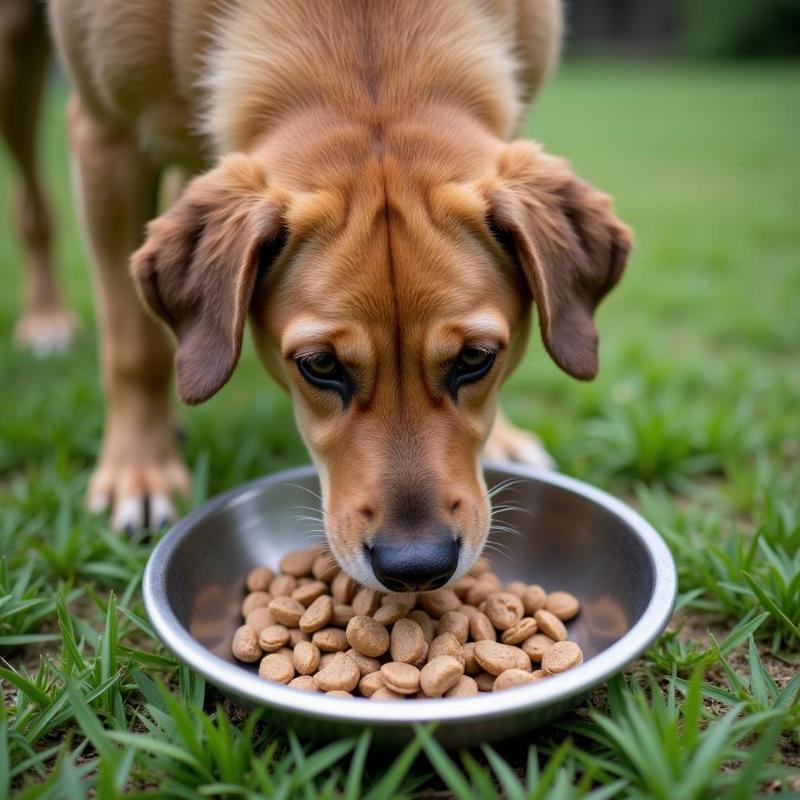Stray dogs face a daily struggle for survival, and finding food is their primary concern. Knowing what to feed a stray dog can make a real difference in their well-being, whether you’re aiming for long-term care or simply offering temporary help. Choosing the right food can be more complicated than it seems, as improper nutrition can lead to health issues. This article will guide you through the best practices for feeding stray dogs in the US, covering everything from suitable food options to important safety considerations.
Choosing the right food for a stray dog involves balancing nutritional needs with practicality and safety. While the image of a stray happily gobbling down table scraps might seem heartwarming, it’s not always the healthiest option. Understanding what constitutes a balanced diet for a dog, and how this can be achieved with readily available resources, is key to helping strays thrive. Furthermore, approaching stray dogs requires caution and awareness, both for your safety and theirs.
Choosing the Right Food
Ideally, stray dogs should be fed food specifically formulated for dogs. Dry kibble is often the most practical choice, offering a good balance of nutrients and a long shelf life. Look for brands that meet the Association of American Feed Control Officials (AAFCO) standards, ensuring they provide complete and balanced nutrition. Avoid foods with artificial colors, flavors, and preservatives.
Wet Food Options
While more expensive than kibble, canned wet food can be a good option, especially for dogs who are underweight or dehydrated. The higher moisture content can help them rehydrate, and the palatability often encourages picky eaters. However, wet food spoils quickly, especially in warm weather, so ensure any leftovers are promptly removed.
Emergency Food Options
In situations where dog food isn’t readily available, certain human foods can be offered as a temporary solution. Cooked plain chicken, rice, and boiled eggs are generally safe and can provide some sustenance. Avoid processed foods, sugary snacks, chocolate, grapes, raisins, onions, and garlic, as these can be toxic to dogs.
 Stray Dog Eating Dry Kibble
Stray Dog Eating Dry Kibble
Safe Feeding Practices
Approaching a stray dog requires caution and respect. Never approach a dog that appears aggressive or fearful. Instead, offer the food from a distance and slowly back away. Avoid making direct eye contact, as this can be perceived as a threat.
Location and Timing
Choose a safe and quiet location for feeding, away from heavy traffic and potential hazards. Establishing a regular feeding schedule can help build trust and make it easier to monitor the dog’s health.
Water is Essential
Always provide fresh, clean water alongside food. Dehydration can be a serious issue for stray dogs, especially during hot weather. A simple bowl of water can make a significant difference.
Avoid Overfeeding
While it’s natural to want to provide as much food as possible, overfeeding can lead to digestive problems and obesity. Start with small portions and observe the dog’s eating habits. Adjust the amount as needed to maintain a healthy weight.
Long-Term Care Considerations
If you’re considering providing long-term care for a stray dog, contacting a local animal shelter or rescue organization is crucial. They can offer guidance on trapping, transporting, and providing appropriate medical care. They can also help determine if the dog has an owner and facilitate reunification.
Health Concerns
Stray dogs are often exposed to parasites and diseases. Providing regular veterinary care, including vaccinations and parasite prevention, is essential for their health and well-being.
Fostering and Adoption
Fostering or adopting a stray dog can be a rewarding experience. Providing a loving home and consistent care can transform a stray’s life. If you’re considering this option, be prepared for the commitment involved in providing for a dog’s physical and emotional needs.
Conclusion
Feeding stray dogs responsibly involves careful consideration of their nutritional needs and safety. Choosing appropriate food, practicing safe feeding habits, and seeking professional assistance when needed can make a significant impact on their well-being. Whether offering a temporary meal or considering long-term care, your actions can make a difference in the life of a stray dog. Remember to always prioritize safety and act responsibly when interacting with stray animals. By understanding what to feed stray dogs and how to approach them safely, you can contribute to their welfare and help create a more compassionate community for animals in need.
FAQ
- What is the best food to give a stray dog? Dry kibble that meets AAFCO standards is often the most practical and nutritious option.
- Can I give a stray dog table scraps? While some human foods are safe, it’s best to stick to dog food to ensure balanced nutrition.
- How should I approach a stray dog? Cautiously and slowly, avoiding direct eye contact and sudden movements.
- What should I do if a stray dog appears aggressive? Do not approach it. Contact animal control or a local rescue organization.
- How can I help a stray dog long-term? Contact a local animal shelter or rescue organization for guidance on trapping, transporting, and providing medical care.
Related Articles on Beautdogs.us
Beautdogs.us is your premier source for comprehensive and reliable information on dog breeds, dog care, and all things dog-related in the US. We offer expert advice, product reviews, and helpful tips for both new and experienced dog owners. From nutrition and training to health and grooming, we’re here to help you provide the best possible care for your canine companion. Contact us for expert advice! Email: [email protected], Phone: +1 501-555-7529. Beautdogs.us is your trusted partner in your dog’s journey.